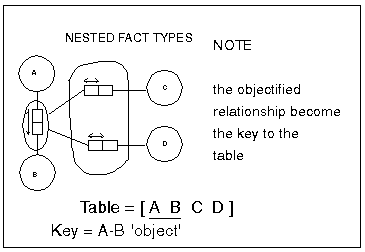The central datatype
for all relational systems is the TABLE. They behave like containers
for your data.
Forming relationally
acceptable tables 'in their best form' is the aim of this section of
the course.
Normalisation
A Conceptual Schema
consists of a set of fully normalised relations - that is fact types
in elementary form. As part of the process of conceptualising a UoD,
each elementary relation is scrutinised, instantiated and (for the most
part) as good as they get.
'Good' database
design balances a number of things - the number of NULLS is balanced
against the number of tables in the resulting relational schema (sub-typing,
as you know, can eliminate the need for nulls).
A CSD, while free
of redundancy, may not always lead to an efficient table design (particularly
if commonly required 'facts' need to be recreated from many disparate
elementary facts). A database designer may choose (after conceptual
analysis) to include columns that are redundant in order that certain
operations are faster. This choice (called controlled redundancy) comes
with enormous risk - update anomalies and referential integrity checks
become very complicated (but not un-manageable) under such schemes.
Field typing, although
explicit as reference modes on a conceptual schema, may need interpreting
based how the implementation is to proceed. Numbers (6.5 as an example
instance) could be stored as a real number (which occupies 6-12 bytes
of memory) or text (1 byte per character = 3 bytes in this example).
The choice bottom-lines on what the values are going to be used for.
Certainly, if numerical quantities are required for mathematical calculation,
then they should be stored as numbers. If, on the other hand no calculation
is required on that numeric field, then storage as text may be justified
- ordering, search and retrieval are just as rapid for a fraction of
the memory cost.
Optimal Normal
Form
Part of the process
of conceptualisation is KEY recognition. Each relation instance is distinct
from every other relation instance by way enforcement of the uniqueness
constraint placed on that relation (during step
4 of ORM). It is appropriate to use the key of the relation to
describe (in part) 'what the fact is about' (i.e. it's context).
When deciding what
fact types should be grouped into which tables, it is reasonable to
expect that relations that are about the same thing should be
grouped together. Similarly, fact types that are keyed differently
are clearly about different things and belong in separate tables.
Un-Normalised relations
involve putting all fields in the one table. Clearly this is inefficient
and inappropriate for a relational system in most cases. Incidently,
this is the way the vast majority of non-relational database products
store their data. Traditionally, Normalisation (First Normal Form up
to 5NF) was employed in table design, successively refining tables,
splitting and testing until the desired result was obtained - this is
time consuming, prone to error and mis-interpretation.
For a given Conceptual
Schema, several relational schemas (table designs) may be suggested.
The Optimal Normal Form Algorithm (Nijssen & Halpin) aims to provide
a simple, safe and efficient table design for a given conceptual schema.
These designs have no repeating fields, no redundancy or update problems
as each fact is stored only once, and a minimum number of tables to
achieve this.
Using ONF, each
fact type is mapped into only one table, with the roles sometimes mapping
into column names. Since the fact type maps onto a single table, the
uniqueness constraints of that fact type become the 'primary' keys for
that table. Other uniqueness constraints provide secondary keys, sub-set
and equality constraints become foreign keys which lace each of the
tables together.
One problem inherited
from a number of flavours of SQL (Oracle, Paradox, Access to name a
few) is the distinction of a primary key for a table. The name implies
that one key (the nominated primary) is more important than other uniqueness
constraints (including foreign keys) - this is simply nonsense. The
total uniqueness picture is as important as each individual key in defining
the behaviour of data stored within the tables. Unfortunately, a number
of the key conditions found in the real world are difficult to implement,
depending on the SQL flavour chosen.
The Optimal Normal
Form Algorithm
What follows is
a simple method of conceptual-relational mapping. Simple and compound
keys are explained as follows:
Simple Keys span
a single role box; Compound/Composite Keys span more than one role box
(a) Group fact
types with simple keys attached to a common object type into the same
table. The primary key for this table is the simple key that was
the basis of the group
Notice, the uniqueness
constraint that is common for both fact types becomes the primary key
for the resulting relation.
Nested fact types
provide cases to apply the same rule as each attribute of the nested
object has a simple (and common) key, therefore the attributes belong
together as they are about the same thing

This picture becomes
a little clouded in flattened form - look for 'object uniqueness' in
groups of high arity facts as these may also be combined into single
tables
Constraints spanning
fact types either provide secondary keys, or form the basis for foreign
keys. Notice that each of the displayed fact types share a simple key
(hence the single table), with the inter-fact type constraint also in
place.
(b) For each
fact type without a simple key, create a separate table. Select
the shortest key of the fact type as the primary key for that table
(c) For each
fact type remaining, create a separate table. Use the key of the
fact type as the primary key of the table.
When the fact type
is a 1:1 (i.e. it has two simple keys) where one of the simple keys
is common with a collection of other fact types). Such a situation calls
for a little common sense and a decision as to whether the fact type
belongs with the others or is about something else. A balance between
the number of tables and the storage efficiency is called for here.
Either way, the fact type will cause a secondary key to exist.
Sub-types present
table designers with decisions - put up with nulls in order that a small
number of tables is obtained OR increase the number of tables (each
sub-type can be its own table) with no nulls.
When deciding on
names for table fields, use either the role or the attached entity or
some combination to ensure the name is meaningful.
The Data Dictionary
An often overlooked
step in table design is the object type listing (otherwise known as
the Data Dictionary). Prudent decisions regarding field types can make
databases easier to manipulate, be efficient in terms of storage space
and to a degree more flexible.
It is suggested
that a list of every field, along with the suggested data types be compiled.
The aim is minimise the number of different types used and standardise
data types across related fields to ensure UNION COMPATIBILITY. This
list will greatly simplify the process of table creation during implementation,
and will allow some complex inter-field operations later.
As has been suggested,
choice of numeric field types may not be efficient in terms of the related
storage space. This is particularly so in those cases where mathematical
computation is unlikely. The saving in storage space, particularly in
large systems can be enormous, without the loss of performance or flexibility.


